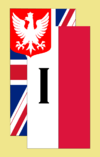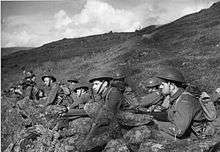I Corps (Polish Armed Forces in the West)


The Polish I Corps (Polish: I Korpus Polski; from 1942, Polish I Armored-Mechanized Corps, Polish: I Korpus Pancerno-Motorowy) was a tactical unit of the Polish Armed Forces in the West during World War II.
It was formed in the United Kingdom on 28 September 1940.[1] It was subordinate to the Scottish Command, and the Corps HQ was located in Perthshire (Moncreiffe House near Bridge of Earn). It numbered 3498 officers and 10,884 soldiers.[1]
Initially formed to protect a 200 kilometres (120 mi) stretch of Scottish shore between the Firth of Forth and Montrose against a possible German invasion of Britain,[1][2] it became the logistical core of the Polish Army fighting alongside the Allies.
Operations

For most of its existence the core of the corps was composed of a variety of en cadre units. Once these had been formed into full tactical units, they were dispatched to the fronts of World War II separately, as part of other Allied tactical units. Among the units created out of First Corps' nominal infantry brigades were 1st Armoured Division, 1st Independent Parachute Brigade, 1st Reconnaissance Regiment and a variety of other detachments.
It was not until after the capitulation of Germany in May 1945 that the corps started to act as a single unit. Its two largest components were joined together in Northern Germany and took part in the occupation of Germany as part of the Allied forces stationed around the port of Wilhelmshaven. Prior to that date both of its main units fought separately and were grouped together mostly for logistical reasons.
Like most other units of the Polish Armed Forces in the West, it was disbanded in 1947, with personnel transferred to the Polish Resettlement Corps.
Commanders
It was commanded by generals Marian Kukiel (1940-1942), Józef Zając (1943), Mieczysław Boruta-Spiechowicz (1943-1945) and Stanisław Maczek (1945-1947).[1]
Subordinate units
Initially the Corps included the HQ, two Rifle Brigades (numbered 1 and 2),[1] five en cadre Rifle Brigades (3, 4, 5, 7 and 8, usually battalion-sized),[1] as well as service units. By late 1940 the Corps had over 14,000 men at arms. The 2nd Rifle Regiment would be reformed into the 10th Armored Brigade on 3 October 1940 which soon in 1942 gave rise to the 1st Armoured Division, and the 4th into the 1st Independent Parachute Brigade on 9 October 1941.[1] The 3, 5 and 7 brigades formed the Training Brigade on 6 December 1941.[1]
During combat operations on the continent, the 1st Armoured Division and the 1st Parachute Brigade were assigned to other Allied commands. The parachute brigade was attached to the First Allied Airborne Army while the armoured division was under the command of the First Canadian Army.
At the end of the war it comprised the 1st Armoured Division, the 1st Independent Parachute Brigade, the 4th Infantry Division, and the 16th Independent Armoured Brigade.[1]
The 16th Armoured Brigade was formed on 1 September 1941 from the 1st Tank Regiment (1 Pułk Czołgów), which was created as a part of the corps in October 1940. On 25 February 1942 the Brigade was assigned to the 1st Armoured Division. In the short period of September to October 1943, the Brigade was merged with the 10th Armoured Brigade to form the 10/16th Armored Brigade. In November 1943 the Brigade was recreated as the 16th (cadre) Independent Armoured Brigade. This unit was not committed to combat on the continent. Until February 1945, it was assigned to the 2nd (cadre) Armoured Grenadier Division.[3]
Notes
- 1 2 3 4 5 6 7 8 9 (Polish) Pierwszy Korpus Polski, WIEM Encyklopedia, accessed November 2011.
- ↑ This stretch of coastline had been quite sparsely defended. On 1 May 1940 9th (Scottish) Division appears to have been responsible for the entire east coast of Scotland.Collier, Defence of the United Kingdom, 1956, Dispositions of Home Forces 1 May 1940, accessed November 2011.
- ↑ Bellis, p. 53
References
- Malcolm Bellis, Commonwealth Divisions 1939 - 1945, Crewe: John Rigby Printers Ltd., 1999. ISBN 0-9529693-0-0.
- Witold Biegański, Krótki informator historyczny o Wojsku Polskim w latach II wojny światowej, tom 5, Regularne jednostki Wojska Polskiego na Zachodzie, Warszawa 1967.
- Józef Dembiniok; Bernard Szczech; Andrzej Urbański (1984). Wojsko Polskie we Francji--I Korpus Polski w Wielkiej Brytanii. Krajowa Agencja Wydawnicza. Retrieved 23 November 2011.
- Tadeusz Kryska-Karski, Stanisław Żurakowski, Generałowie Polski Niepodległej, Warszawa 1991.